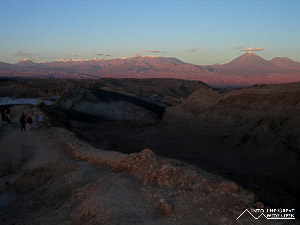San Pedro de Atacama, Chile
The Atacama Desert
March 9, 2008
Sunshine bores the daylights out of me
Chasing shadows, moonlight mystery
- The Rolling Stones

With the coast road closed I headed through the driest part of the Atacama Desert on the way to Tocopilla. In most deserts you see the places where water runs when it does rain but in this part of the Atacama you don´t see that because, well, it never rains. There are places where there has not been any rainfall in the recent span of recorded history. I was heading to Tocopilla because I was hoping that it would be a charming little seaside town and because my guidebook said that it had the most dramatic setting of any Chilean city, and after coming from Iquique I thought that would really be something to see. In retrospect, it was a bad decision. If you have the chance, don´t go to Tocopilla. It might be worth it if you can take the road along the coast but otherwise try to avoid it. Much of the city is deteriorating and there is little, if anything, of interest amidst the overpriced main street and the setting really isn´t that special. Iquique is much better. After paying way too much money for an ancient hotel room I took the first bus out in the morning to Calama.
In Calama I was hoping to take a tour of the immense copper mine at Chuquicamata, the largest copper mine in the world with a 4 km long, 2 km wide, and 730 meter deep mining pit that is visible from space. The tours had unfortunately been suspended indefinitely since mid-February due to maintenance on the vantage point over the pit. With nothing else to keep me in Calama I took a bus to San Pedro de Atacama to see the desert landscapes.

San Pedro de Atacama, apart from the scenery, is not really a pleasant place in any way. Over-run with tourists and tour operators, the tiny town of 2,000 people seemingly has more tourists than residents. Every tour agency offers the exact same tours at the same times so you will certainly never be alone at any of the sights. And even for Chile, the most expensive country in South America apart from French Guyana, San Pedro is outrageously expensive with prices for most things as much as or more than those in United States. The surrounding scenery is very beautiful with desert landscapes, high altitude lakes, and snow covered volcanoes.
Even with so many tour operators it was amazingly difficult to get a spot on the evening tour to the Valley of the Moon and the Valley of Death. Nearly every place was full but after asking at every single tour operator some spots finally opened up. The Valley of Death was first, with sand dunes and eroded rock formations, followed by the Valley of the Moon for sunset, with similar landscapes and panoramic views of some salt deposits and the snow-covered peaks towards the Bolivian and Argentinian borders. Once the sun sets, the temperature drops rapidly and it gets quite cold at night.

I was forced to spend an extra day in San Pedro because there are only buses to Argentina on Tuesdays, Fridays, and Sundays and the Friday bus was already full. On the extra day I took a bus to Tocanao, about 30 km away to walk around the town and see the Valley of Jere, which has a river gorge with an oasis. The gorge was pleasant with irrigation channels carrying the river water to crop fields in the gorge. Near the gorge there is a quarry where they extract sillar, a white volcanic rock that was used to construct many of the older houses in the town. Things in this small town of about 500 people were much cheaper than in San Pedro, but unfortunately the main local store closed early in the afternoon and I couldn´t buy food for my 12-hour bus trip to Salta the next day. There wasn´t anything else to do in the town so I was forced to sit around and wait for about 2 hours for the return bus to San Pedro.
I was looking forward to going to Argentina because despite all its beautiful scenery, northern Chile didn´t have much to offer in the way of culture. At least these few cities I visited in the north all seemed so modern and culture-less that they could have been cities in the middle of the United States.

Coming from Peru it was certainly a shock when I saw the prices of things, compared to the other South American countries, Chile has the most advanced and developed economy, with nearly a third of its economy depending on mining exports, principally copper. There is such a vast difference between Peru and Chile that crossing the border between Arica and Tacna is similar to that between San Diego and Tijuana, everything rapidly changes as you move towards the less developed country, and usually not for the better. In Peru there is some form of a controlled chaos, with no traffic control or much law enforcement; it is widely accepted, especially in rural areas to just go to the bathroom anywhere that is convenient. In Chile there are traffic lights, bathrooms are utilized, laws are followed on faith even if no one is there to enforce them; it makes for a striking difference. In many ways I miss the controlled chaos of Peru and Ecuador, that and the presence of the indigenous cultures there made it more interesting. I hope that Argentina will have more culture, although I have heard that it is very modern, with Buenos Aires especially resembling Europe.
















































